Method for Prediction of Extreme Wave Loads Based on Ship Operability Analysis Using Hindcast Wave Database
Abstract
:1. Introduction
- Without any operational restrictions, i.e., for all sea states that ship could potentially encounter along the route;
- Full operational restrictions, i.e., the case when sea states not satisfying any of the operational criteria are avoided;
- Partial operability restrictions, i.e., the case when speed is considerably reduced for sea states not satisfying any of the operational criteria.
2. Ship and Shipping Route
2.1. Ship Particulars
2.2. Shiping Route
3. Operability Analysis
3.1. Transfer Functions for Motions
3.2. Wave Data
3.3. JONSWAP Wave Spectrum
3.4. Operability Criteria and Limits
4. Method for the Prediction of Extreme Wave Loads
5. Results
5.1. Operability Plot
5.2. Probability Distributions of Extreme VWBM at Individual Locations
5.3. System Probabilities
5.4. The Effect of the Speed Reduction in Severe Sea States
6. Discussion
7. Conclusions
- Operational criteria are not satisfied in 2–4% of sea states in four locations along the shipping route.
- If sea states where operability criteria are not satisfied are completely avoided, long-term extreme vertical wave bending moment is reduced by a factor of 2.
- If ship speed is reduced to the minimum cruising speed in sea states where operability criteria are not satisfied, instead of avoiding those sea states, long-term extreme vertical wave bending moment is reduced by about 20%.
- If the assumption of full statistical correlation among sea states along the shipping route is adopted, long-term extreme vertical wave bending moment is reduced by 8–21%. It should be mentioned that wave data in the database indicate that assumption of correlation is justified for this specific, relatively short shipping route.
Author Contributions
Funding
Institutional Review Board Statement
Acknowledgments
Conflicts of Interest
Appendix A. Annual Maximum Vertical Wave Bending Moments
Appendix A.1. All Sea States
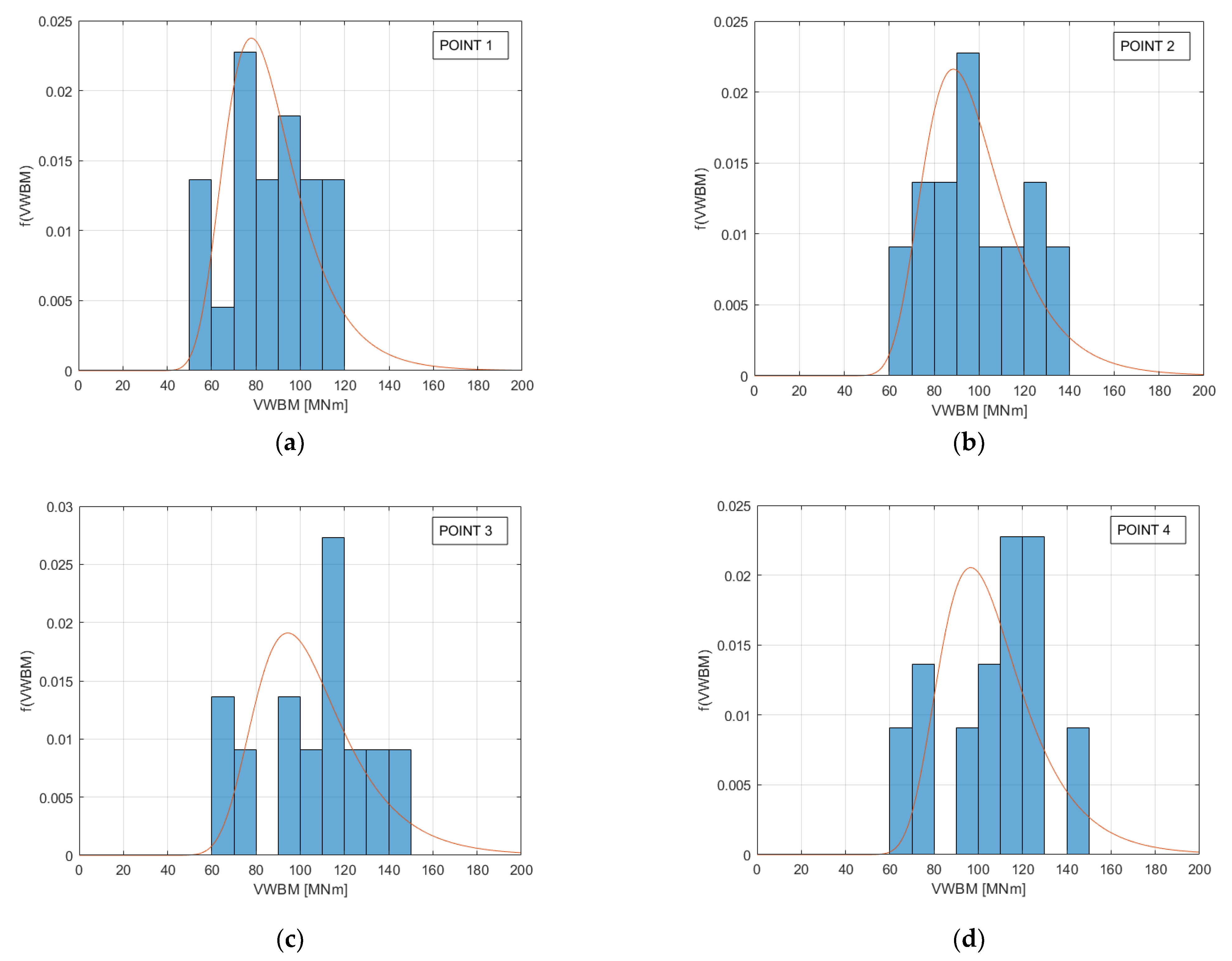
Appendix A.2. Sea States Satisfying Operability Criteria on the Sailing Route from Split to Ancona
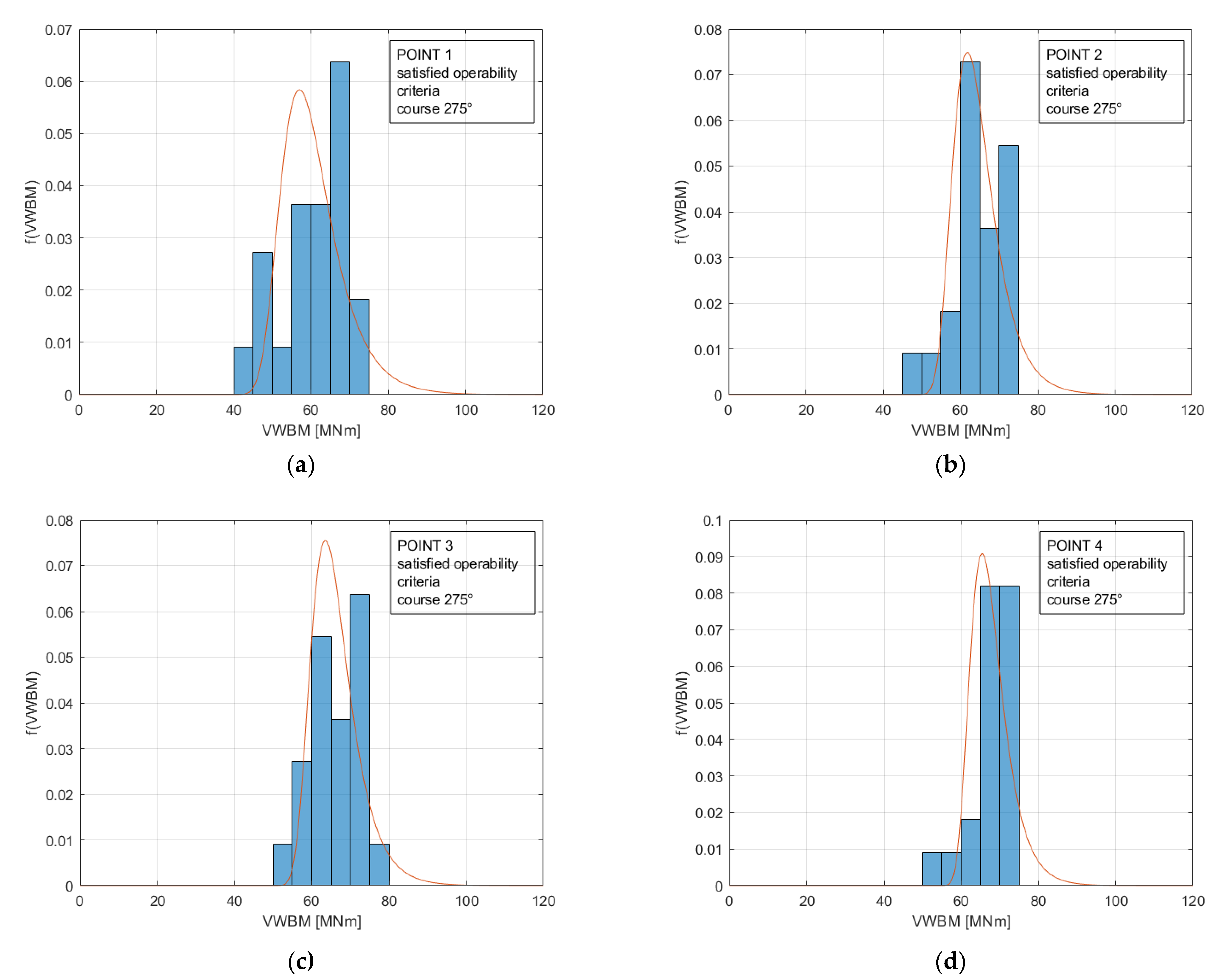
Appendix A.3. Sea States Satisfying Operability Criteria on the Sailing Route from Ancona to Split
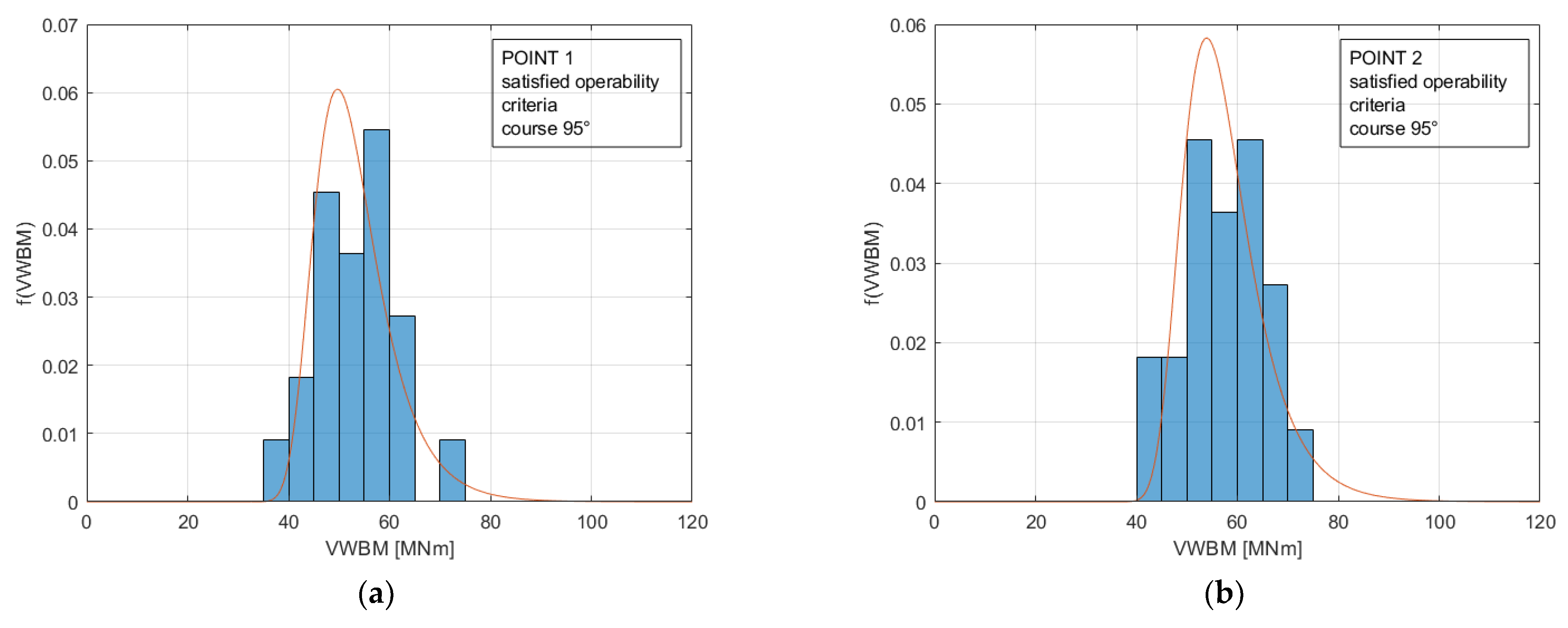
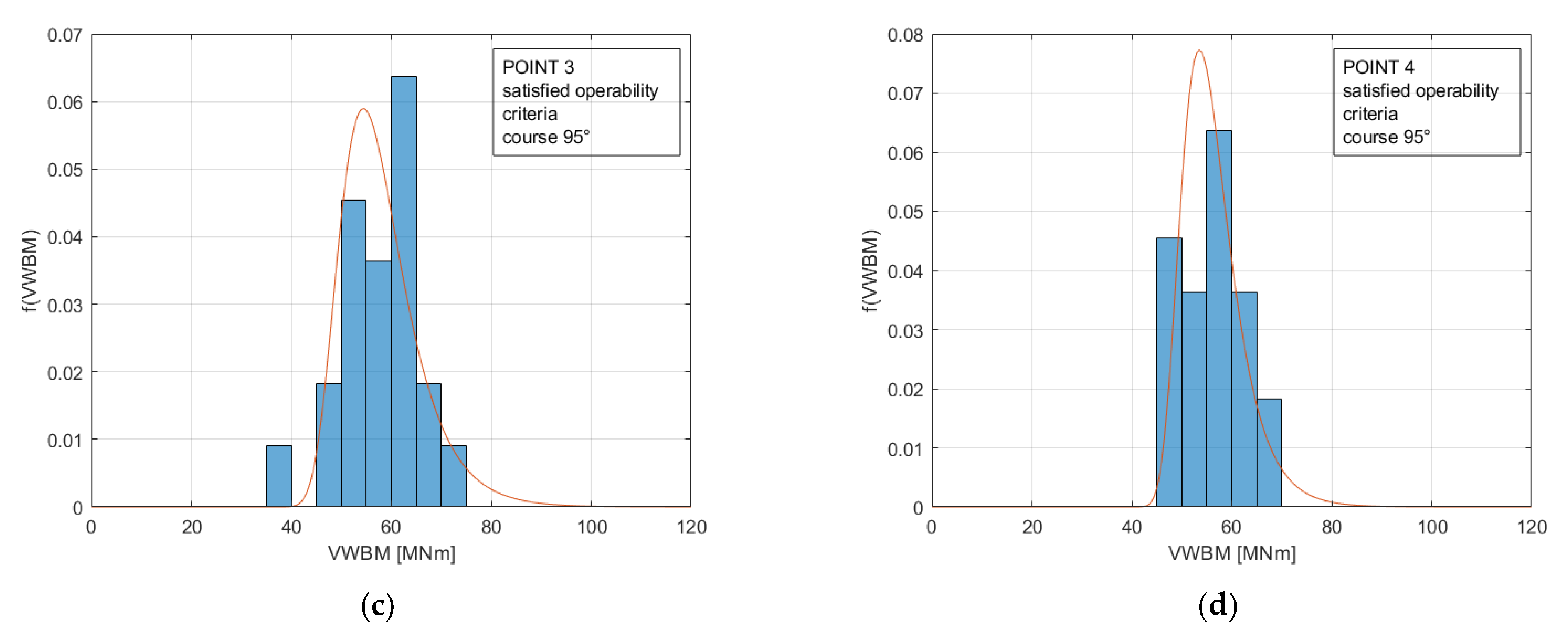
Appendix B. Annual Maximum Vertical Wave Bending Moments for a Case of Reduced Speed on Sea States That Do Not Meet Operability Criteria
Appendix B.1. Voyage from Split to Ancona

Appendix B.2. Voyage from Ancona to Split
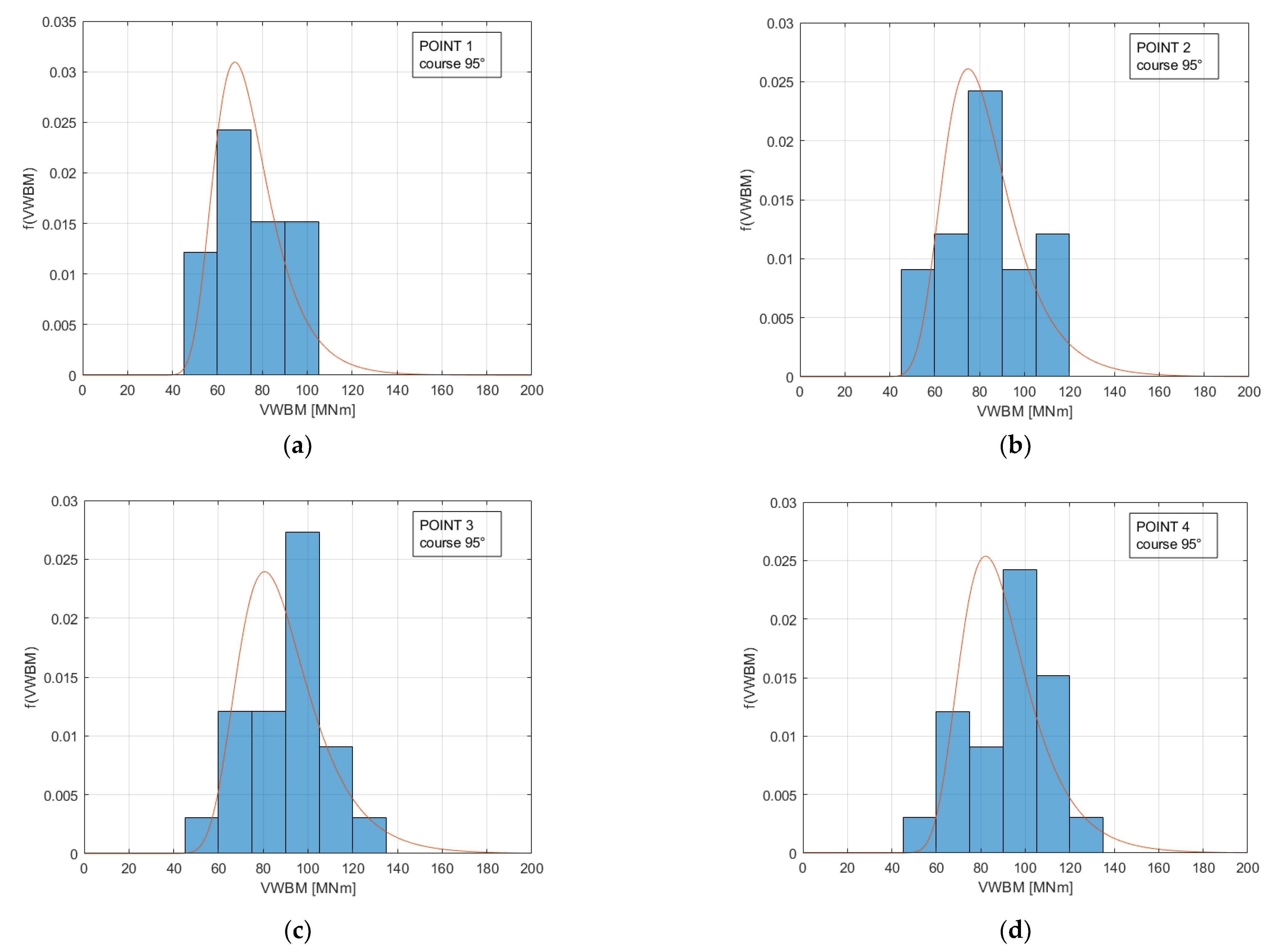
References
- IACS Rec. No. 34. Standard Wave Data; IACS: London, UK, 2001. [Google Scholar]
- Moan, T.; Shu, Z.; Drummen, I.; Amlashi, H. Comparative reliability analysis of ships—Considering different ship types and the effect of ship operations on loads. Trans. Soc. Nav. Archit. Mar. Eng. 2007, 114, 16–54. [Google Scholar]
- Guedes Soares, C. On the Definition of Rule Requirements for Wave Induced Vertical Bending Moments. Mar. Struct. 1996, 9, 409–425. [Google Scholar] [CrossRef]
- Prpić-Oršić, J.; Parunov, J.; Šikić, I. Operation of ULCS—Real Life. Int. J. Nav. Archit. Ocean. Eng. 2014, 6, 1014–1023. [Google Scholar] [CrossRef]
- Hogben, N.; Dacunha, N.M.C.; Oliver, G.F. Global Wave Statistics; Feltham: British Maritime Technology Ltd.: London, UK, 1986. [Google Scholar]
- Bitner-Gregersen, E.M.; Dong, S.; Fu, T.; Ma, N.; Maisondieu, C.; Miyake, R.; Rychlik, I. Sea state conditions for marine structures’ analysis and model tests. Ocean. Eng. 2016, 119, 309–322. [Google Scholar] [CrossRef] [Green Version]
- Derbanne, Q.; Shiguntov, V.; Storhaug, G.; Xie, G.; Zheng, G. Rule formulation of vertical hull girder wave loads based on direct computation. In Proceedings of the PRADS 2016, Copenhagen, Denmark, 4–8 September 2016. [Google Scholar]
- de Hauteclocque, G.; Johnson, M.; Zhu, T.; Austefjord, H.; Bitner-Gregersen, E. Assesment of global wave datasets for long term response of ships. In Proceedings of the ASME 2020 39th International Conference on Ocean, Offshore and Arctic Engineering OMAE 2020, Fort Lauderdale, FL, USA, 28 June–3 July 2020. [Google Scholar]
- Perrault, D.E. Probability of Sea Condition for Ship Strength, Stability, and Motion Studies. J. Ship Res. 2021, 65, 1–14. [Google Scholar] [CrossRef]
- Schirmann, M.L.; Collette, M.D.; Gose, J.W. Significance of wave data source selection for vessel response prediction and fatigue damage estimation. Ocean. Eng. 2020, 216, 107610. [Google Scholar] [CrossRef]
- Vettor, R.; Guedes Soares, C. Assessment of the Storm Avoidance Effect on the Wave Climate along the Main North Atlantic Routes. J. Navig. 2016, 69, 127–144. [Google Scholar] [CrossRef] [Green Version]
- Jensen, J.J.; Mansour, A.E.; Olsen, A.S. Estimation of ship motions using closed-form expressions. Ocean. Eng. 2004, 31, 61–85. [Google Scholar] [CrossRef]
- Ghaemi, M.H.; Olszewski, H. Total ship operability -review, concept and criteria. Pol. Marit. Res. 2017, 24, 74–81. [Google Scholar] [CrossRef] [Green Version]
- Katalinić, M.; Parunov, J.; Mikulić, A. Toward operability analysis of a passenger ship in the Adriatic Sea based on the JONSWAP-Adriatic wave spectrum. In Proceedings of the XXIV Symposium Theory and Practice of Naval Architectures (SORTA 2020), Malinska, Croatia, 15–17 October 2020. [Google Scholar]
- Petranović, T.; Katalinić, M.; Mikulić, A.; Parunov, J. Operability study of passenger ship in the Adriatic Sea using hindcast database. In Proceedings of the 8th International Conference on Marine Structures (MARSTRUCT 2021), Trondheim, Norway, 7–9 June 2021. [Google Scholar]
- Katalinić, M.; Parunov, J. Comprehensive Wind and Wave Statistics and Extreme Values for Design and Analysis of Marine Structures in the Adriatic Sea. J. Mar. Sci. Eng. 2021, 9, 522. [Google Scholar] [CrossRef]
- Katalinić, M.; Ćorak, M.; Parunov, J. Optimized Wave Spectrum Definition for the Adriatic Sea. Naše More 2020, 67, 19–23. [Google Scholar] [CrossRef] [Green Version]
- DNV GL. Recommended Practice DNVGL RP C-205: Environmental Conditions and Environmental Loads; Edition August 2017; Det Norske Veritas Germanischer Lloyd: Oslo, Norway, 2017. [Google Scholar]
- Lloyd, A.R.J.M. Seakeeping: Ship Behaviour in Rough Water; Gosport: Hampshire, UK, 1998. [Google Scholar]
- Scamardella, A.; Piscopo, V. Passenger ship seakeeping optimization by the Overall Motion Sickness Incidence. Ocean. Eng. 2014, 76, 86–97. [Google Scholar] [CrossRef]
- DNV GL. Class Guideline DNVGL CG 0130: Wave Loads; Det Norske Veritas Germanischer Lloyd: Oslo, Norway, 2018. [Google Scholar]
- Mansour, A.; Liu, D. The Principles of Naval Architecture Series: Strength of Ships And Ocean Structures; The Society of Naval Architects and Marine Engineers: Jersey City, NJ, USA, 2008; pp. 4–56. [Google Scholar]
- Katalinić, M.; Parunov, J. Uncertainties of Estimating Extreme Significant Wave Height for Engineering Applications Depending on the Approach and Fitting Technique—Adriatic Sea Case Study. J. Mar. Sci. Eng. 2020, 8, 259. [Google Scholar] [CrossRef] [Green Version]
- Mansour, A.E.; Preston, D.B. Return periods and encounter probabilities. Appl. Ocean. Res. 1995, 17, 127–136. [Google Scholar] [CrossRef]
- Mikulić, A.; Katalinić, M.; Ćorak, M.; Parunov, J. The effect of spatial correlation of sea states on extreme wave loads of ships. Ships Offshore Struct. 2021, 16 (Suppl. S1), 22–32. [Google Scholar] [CrossRef]
- Ćorak, M.; Parunov, J.; Guedes Soares, C. Long-term prediction of combined wave and whipping bending moments of container ships. Ships Offshore Struct. 2015, 10, 4–19. [Google Scholar] [CrossRef]
- Jiao, J.; Ren, H.; Guedes Soares, C. A review of large-scale model at-sea measurements for ship hydrodynamics and structural loads. Ocean. Eng. 2021, 227, 108863. [Google Scholar] [CrossRef]
- Mudronja, L.; Katalinić, M.; Vidan, P.; Parunov, J. Route planning based on ship roll in numerically modelled heavy seas. In Proceedings of the XXII Symposium Theory and Practice of Naval Architectures (SORTA 2016), Trogir, Croatia, 6–8 October 2016. [Google Scholar]
- World Meteorological Organization. Guide to Wave Analysis and Forecasting; Secretariat of the World Meteorological Organization: Geneva, Switzerland, 1998. [Google Scholar]
- Lavidas, G.; Venugopal, V. Wave energy resource evaluation and characterisation for the Libyan Sea. Int. J. Mar. Energy 2017, 18, 1–14. [Google Scholar] [CrossRef] [Green Version]
- Mansour, A.E.; Wasson, J.-P. Charts for Estimating Nonlinear Hogging and Sagging Bending Moments. J. Ship Res. 1995, 39, 240–249. [Google Scholar] [CrossRef]
- Mansour, A.E.; Jensen, J.J. Slightly Nonlinear Extreme Loads and Load Combinations. J. Ship Res. 1995, 39, 139–149. [Google Scholar] [CrossRef]

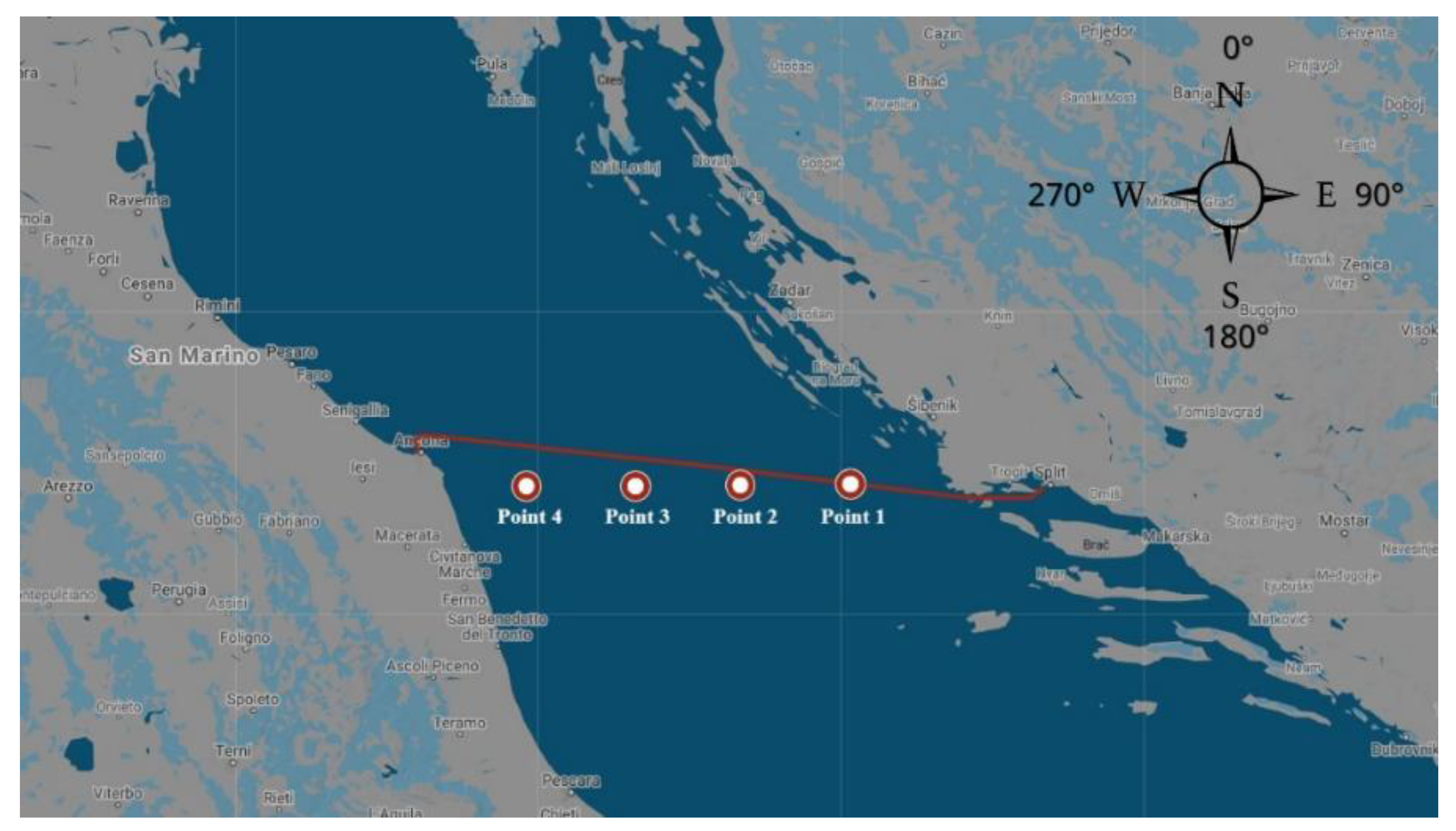
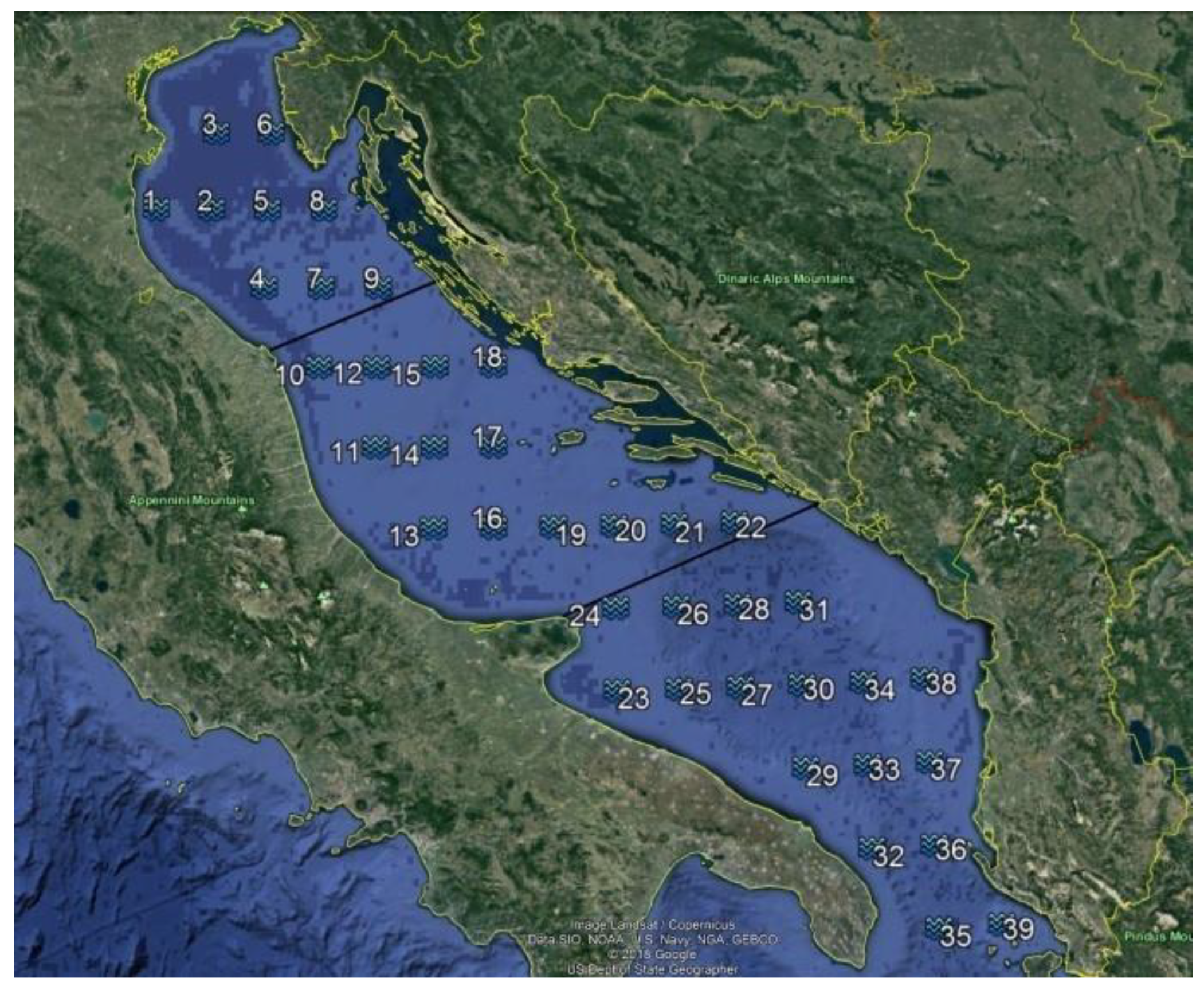
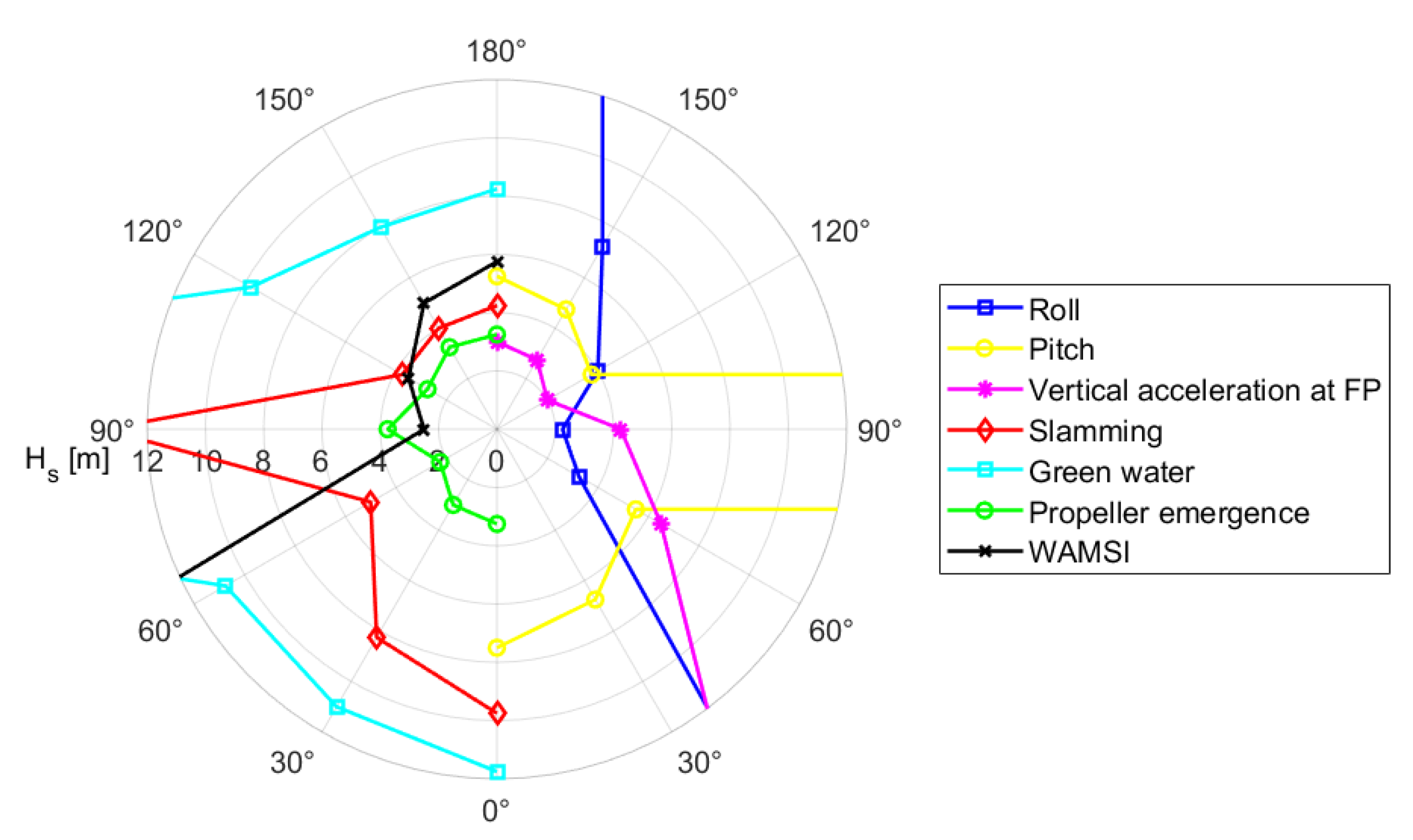
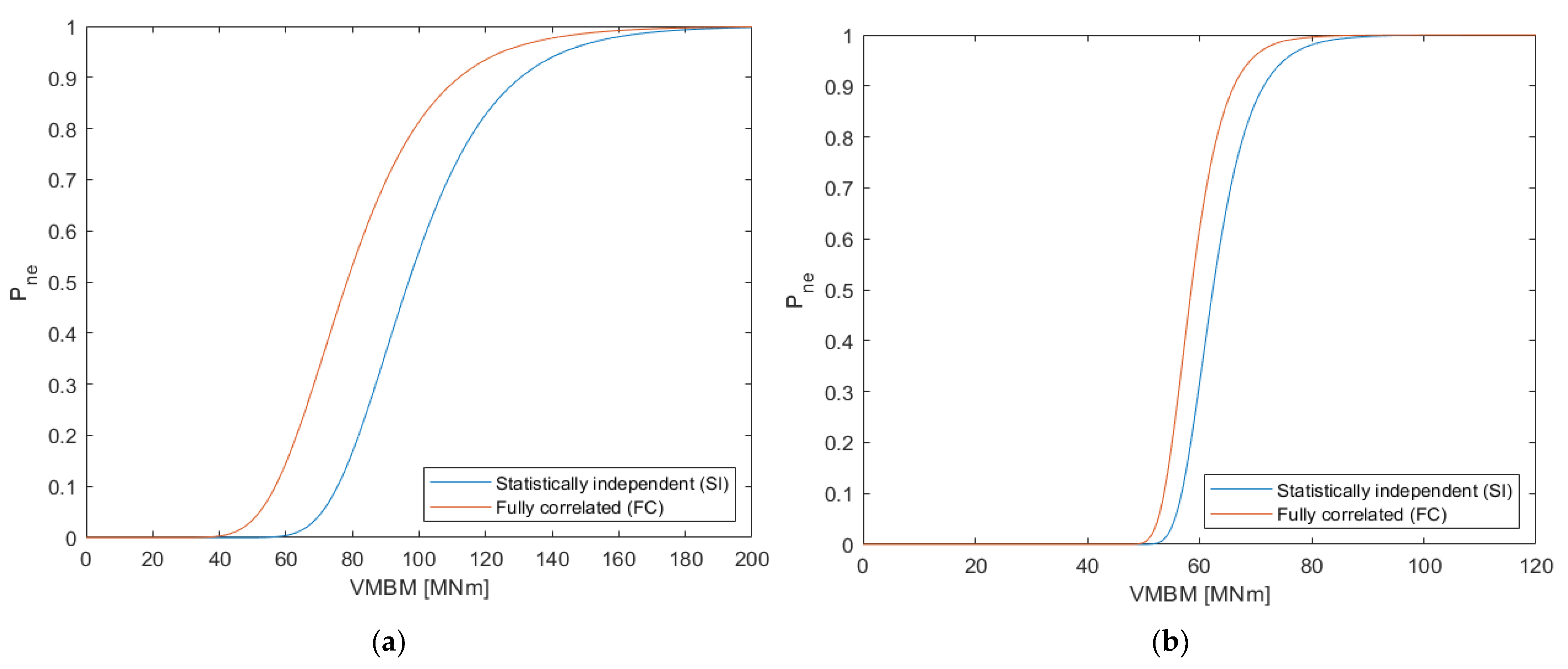
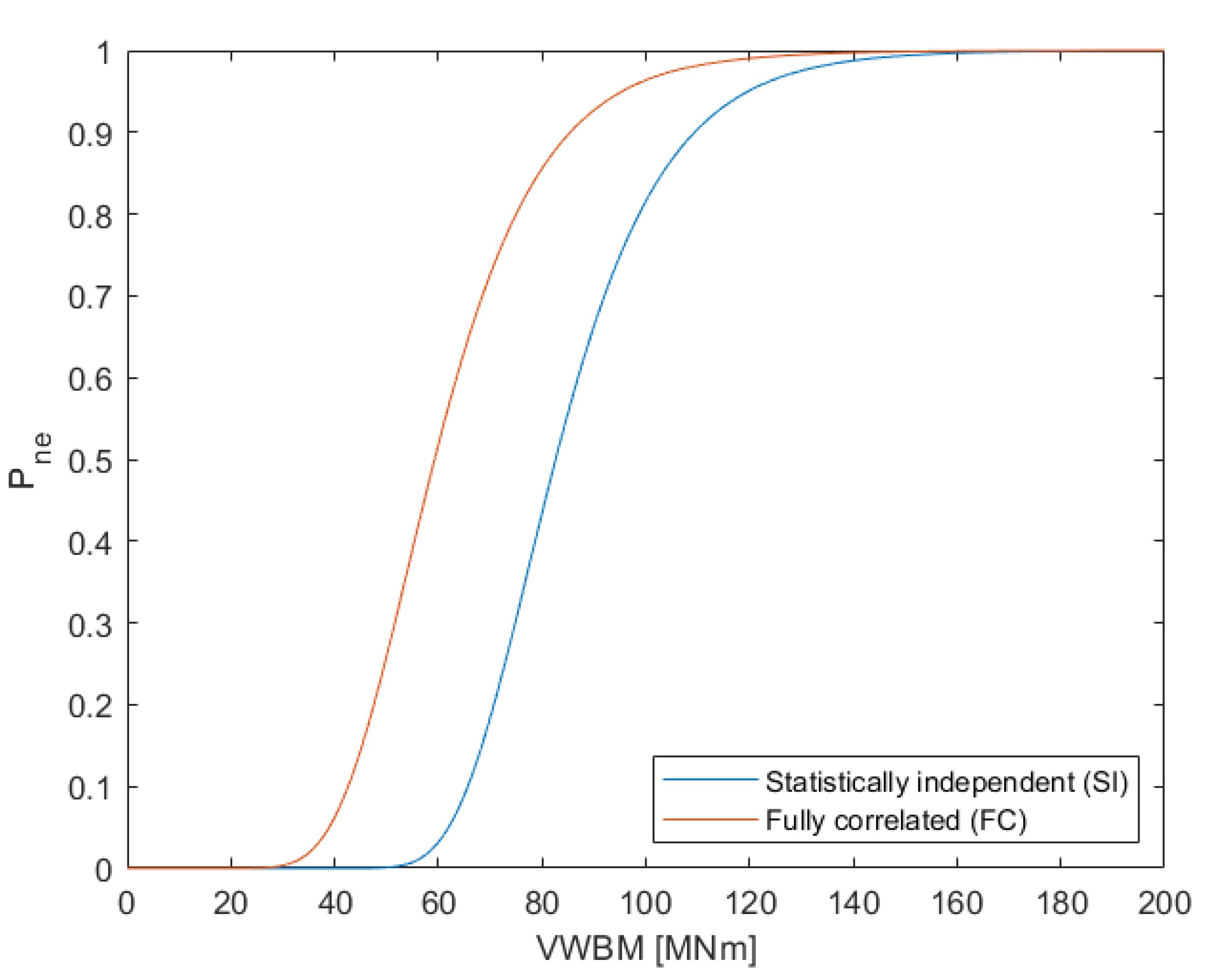
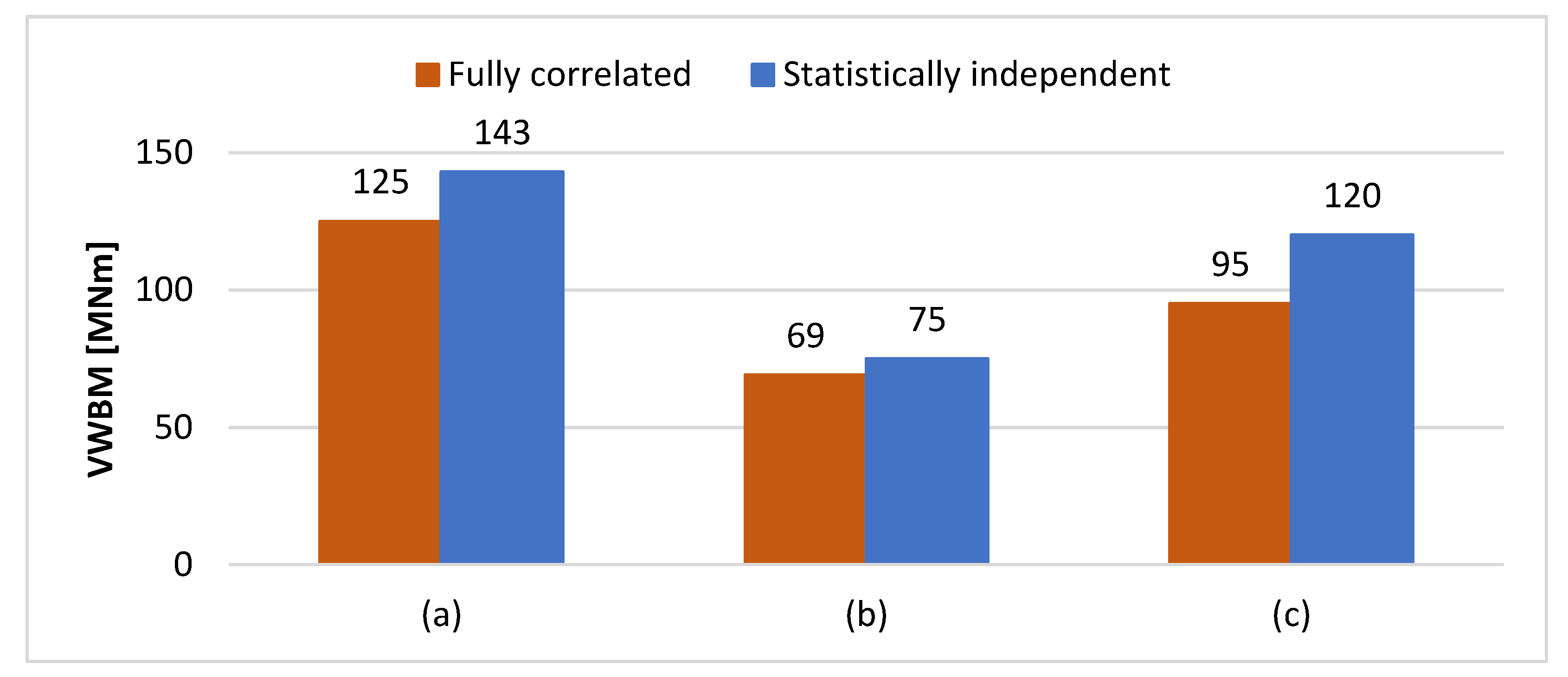
| Particular | Value | Measuring Unit | Description |
|---|---|---|---|
| 114 | m | Length overall | |
| 103.2 | m | Length between perpendiculars | |
| 18.7 | m | Width | |
| 5 | m | Draft | |
| 6565 | t | Displacement | |
| 0.617 | - | Block coefficient | |
| 1.94 | m | Metacentric height | |
| 17 | kn | Maximum speed |
| Point in the Adriatic Sea | Latitude (°) | Longitude (°) |
|---|---|---|
| Point 1 | 43.5 | 15.5 |
| Point 2 | 43.5 | 15 |
| Point 3 | 43.5 | 14.5 |
| Point 4 | 43.5 | 14 |
| Point in the Adriatic Sea (Figure 2) | Max. | Date |
|---|---|---|
| 1 | 5.89 | 29 October 2018 |
| 2 | 6.18 | 29 October 2018 |
| 3 | 5.98 | 29 October 2018 |
| 4 | 5.65 | 11 November 2013 |
| Operability Criterion | Limiting Value |
|---|---|
| RMS of roll | 2.5° |
| RMS of pitch | 1.5° |
| RMS of vertical acceleration at FP | 0.05 g |
| Probability of slamming | 0.03 |
| Probability of green water | 0.05 |
| Probability of propeller emergence | 0.25 |
| WAMSI | 20% in 4 h |
| Point | Operability Criteria | |||||||
|---|---|---|---|---|---|---|---|---|
| Roll | Pitch | Vertical Acc. at FP | Slamming | Green Water | Propeller Emergence | WAMSI | Total | |
| 1 | 0.40 | 0 | 0.11 | 0 | 0 | 1.89 | 0.01 | 2.06 |
| (0.17) | (0.04) | (2.12) | (0.11) | (0) | (1.14) | (0.14) | (2.62) | |
| 2 | 0.36 | 0 | 0.11 | 0 | 0 | 2.13 | 0.01 | 2.25 |
| (0.16) | (0.07) | (2.76) | (0.17) | (0) | (1.34) | (0.15) | (3.24) | |
| 3 | 0.38 | 0 | 0.11 | 0 | 0 | 2.02 | 0.02 | 2.15 |
| (0.22) | (0.07) | (2.89) | (0.18) | (0) | (1.38) | (0.18) | (3.40) | |
| 4 | 0.55 | 0 | 0.09 | 0.003 | 0 | 1.82 | 0.02 | 1.97 |
| (0.36) | (0.08) | (3.44) | (0.23) | (0) | (1.56) | (0.23) | (4.03) | |
| Point (Figure 2) | Long-Term Extreme VWBM for 20-Year Return Period (MNm) | ||
|---|---|---|---|
| All Sea States | Sea States Satisfying Operability Criteria | ||
| Split–Ancona 275° | Ancona–Split 95° | ||
| 1 | 124 | 76 | 68 |
| 2 | 139 | 76 | 73 |
| 3 | 152 | 78 | 73 |
| 4 | 150 | 77 | 68 |
| VWBM (MNm) Determined from | VWBM (MNm) Determined from | |
|---|---|---|
| All sea states | 125 | 143 |
| Sea states satisfying operability criteria | 69 | 75 |
| Point (Figure 2) | Long-Term Extreme VWBM for 20-Year Return Period (MNm) | |
|---|---|---|
| Split–Ancona 275° | Ancona–Split 95° | |
| 1 | 104 | 103 |
| 2 | 116 | 117 |
| 3 | 126 | 126 |
| 4 | 124 | 125 |
| VWBM (MNm) Determined from | VWBM (MNm) Determined from |
|---|---|
| 95 | 120 |
Publisher’s Note: MDPI stays neutral with regard to jurisdictional claims in published maps and institutional affiliations. |
© 2021 by the authors. Licensee MDPI, Basel, Switzerland. This article is an open access article distributed under the terms and conditions of the Creative Commons Attribution (CC BY) license (https://creativecommons.org/licenses/by/4.0/).
Share and Cite
Petranović, T.; Mikulić, A.; Katalinić, M.; Ćorak, M.; Parunov, J. Method for Prediction of Extreme Wave Loads Based on Ship Operability Analysis Using Hindcast Wave Database. J. Mar. Sci. Eng. 2021, 9, 1002. https://doi.org/10.3390/jmse9091002
Petranović T, Mikulić A, Katalinić M, Ćorak M, Parunov J. Method for Prediction of Extreme Wave Loads Based on Ship Operability Analysis Using Hindcast Wave Database. Journal of Marine Science and Engineering. 2021; 9(9):1002. https://doi.org/10.3390/jmse9091002
Chicago/Turabian StylePetranović, Tamara, Antonio Mikulić, Marko Katalinić, Maro Ćorak, and Joško Parunov. 2021. "Method for Prediction of Extreme Wave Loads Based on Ship Operability Analysis Using Hindcast Wave Database" Journal of Marine Science and Engineering 9, no. 9: 1002. https://doi.org/10.3390/jmse9091002
APA StylePetranović, T., Mikulić, A., Katalinić, M., Ćorak, M., & Parunov, J. (2021). Method for Prediction of Extreme Wave Loads Based on Ship Operability Analysis Using Hindcast Wave Database. Journal of Marine Science and Engineering, 9(9), 1002. https://doi.org/10.3390/jmse9091002







